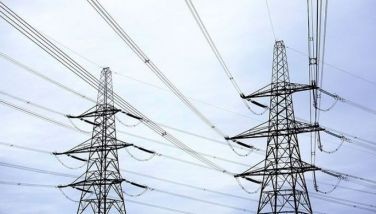Resources and people: End of the line?

“Your middle name must be Nostradamus,” Dr. Ricky Soler kidded me one morning at the Tuesday Club. “You have written about all of these crazy things months ago that are happening now. You give me a headache every time I read you.”
“Well,” I said, “you’re a psychiatrist. You can write yourself a prescription of Prozac and get happy with the happy pill.” Oh well… it isn’t my job to make people happy. It is my job to give people information to make them think and get mad enough to do something to mitigate the risks of potential crises.
I get Dr. Ricky’s point. But he must also understand that while it is no fun reading about shortages, corruption and bureaucratic incompetence, it is no fun writing about them too. Whoever said work is supposed to be fun? There are days I feel like calling Dr. Ricky for an hour’s worth of psychoanalysis to help rid myself of the gloom I get infected with after a day’s work.
No dice! Dr. Ricky has made it clear he is no longer into that sort of thing. He has had it with psychiatric hypochondriacs like me. Now, Dr. Ricky is into making paella for parties. He also is involved with this business of cleansing toxins out of our harassed bodies using natural enzymes. He loves best helping his sons run Goodah and this place in Taytay called Club Manila East where they teach people how to surf with the use of a wave making machine….like manufacturing artificial tsunamis.
Dr. Ricky the ex-Shrink has found a drug-free way to happiness by helping out the entrepreneurial ventures of his children and he has eight or nine of them. I can say that this strategy works. I too, find helping my children in these formative years of their careers such a rewarding experience. Except that I can’t help worrying about the kind of messy world they have to live in. My bedside reading materials are basically to blame for my fears.
I was just starting to read Collapse, the latest book of anthropologist Jared Diamond. It is a fascinating account of how civilizations collapsed through the ages. All collapsed because of environmental abuse. All collapsed because of the misconduct of those within the society. All these societies caused their own demise.
In reviewing Diamond’s work, Nobel Prize winning economist Joseph Stiglitz noted how Diamond provided an incisive catalog of the explanation based on both rational and irrational behavior. “As one reads these accounts, one thinks of modern parallels, and lest we miss the point, the author provides a detailed description of environmental problems around the world today, from Montana to China to Australia.”
I felt exactly as Stiglitz did in reading Collapse. “A reader cannot help but leave the book wondering whether we are following the track of these other civilizations that failed, ignoring the signals that there is an impending problem, somehow hoping that in the end technology will save the day.”
Technology? Yes, technology did help us boost rice production during the glory days of the Green Revolution. But the guys in IRRI, who should know technology and rice, are telling us that technology may no longer be there this time. We had not invested enough in technology in recent years and there are other things besides that affect our ability to plant enough rice to fill our bellies. One constraint: we are running out of earth.
That is exactly the title of Paul Krugman’s column last Monday at the New York Times: Running Out of Planet to Exploit. We are now experiencing historic sky high prices for energy and food and it seems we haven’t seen anything yet. It is easy for some people to blame speculation as the cause of the price bubbles. But Krugman, an economist at Princeton, says it must be more than that.
“Normally, speculation drives up commodity prices by promoting hoarding. Yet there’s no sign of resource hoarding in the data: inventories of food and metals are at or near historic lows, while oil inventories are only normal.” Krugman recalls a similar thing happening in the 70s: soaring oil prices and lines at gas stations. But there was also a severe global food crisis, which caused a lot of pain at the supermarket checkout line.”
But he thinks “this time may be different: concerns about what happens when an ever-growing world economy pushes up against the limits of a finite planet ring truer now than they did in the 1970s.” In the 70s, a downshift in the Japanese and European economies took a lot of pressure off the world’s resources. Today, we have China and India.
Today, Krugman points out, “resources are getting harder to find. Big oil discoveries, in particular, have become few and far between, and in the last few years oil production from new sources has been barely enough to offset declining production from established sources. And the bad weather hitting agricultural production this time is starting to look more fundamental and permanent than El Niño and La Niña, which disrupted crops 35 years ago. Australia, in particular, is now in the 10th year of a drought that looks more and more like a long-term manifestation of climate change.”
So, he asks, “suppose that we really are running up against global limits. What does it mean?” Well… “rich countries will face steady pressure on their economies from rising resource prices, making it harder to raise their standard of living. And some poor countries will find themselves living dangerously close to the edge — or over it.”
Don’t look now, Krugman says, but the good times may have just stopped rolling for the developed world. Too bad for us, it hasn’t even really begun in earnest.
Poor planning
We received this e-mail from an OFW reacting to a previous column.
I don’t know if it’s just me who notices it. But it seems like too many government offices that are crucial in driving job creation are being led or have been led by either political appointees or bureaucrats who cannot conceive creative end-to-end solutions. You have written extensively about problems in tourism. Another obvious sign that something is wrong is the fact that Filipinos make up only 250,000, or 25 percent, of all seafarers. If we can deploy 25 percent, why not 50 percent and make it 500,000? Or 75 percent for 750,000?
It has also been reported in the Fil-Am press that the Philippines cannot fill the demand for skilled construction jobs in the Middle East. Saudi Arabia alone, for example, supposedly has need for more than 300,000 construction workers, but the Philippines is struggling to deploy only 100,000.
These, among others, prove several things about our executive branch officials: (1) they are weak when it comes to anticipating demand, (2) if ever any agency has useful information that could help, this information is not communicated with other agencies and (3) even after demand materializes, they don’t work together to find end-to-end solutions for fixing supply-side problems.
Economists in investment banks and multilateral organizations have been predicting trends in the global job market for years. Did NEDA know about these trends and did it communicate and follow-through this knowledge with other government agencies? Does the DOT, DOLE, POEA and TESDA solicit forecasts from NEDA, or do they do their own forecasting, if at all? What is the strategy of the DOT, DOLE, POEA and TESDA for Filipinos to tap large-scale job opportunities in wholesale manner, and how have they executed these strategies so far?
It’s amazing to see the Philippines get stressed over jobs in the thousands at stake with big issue-laden investments made by Intel, FEDEX, Hanjin and SMC and yet pass over jobs in the hundreds of thousands in situations where it has a clear advantage. It makes me want to ask the question - “What’s going on?”
Pinoy joke
Zenaida Duque forwarded another Pinoy joke.
Boy: Nay, meron ba tayong ulam?
Nanay: Tignan mo na lang dyan sa ref, anak.
Boy: Eh wala naman tayong ref, di ba?
Nanay: O, e di wala tayong ulam. Konting common sense naman dyan!
Boo Chanco’s e-mail address is [email protected]
- Latest
- Trending





























